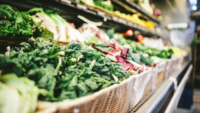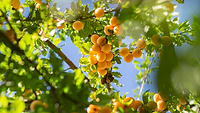Distribution of Chlorpyrifos Residues in Citrus Fruits

Citrus fruits partly owe their popularity to the high levels of vitamin C they provide and are considered an essential part of a healthy diet. During their production and postharvesting in conventional agriculture, the application of plant protection agents is required to ensure agricultural yield and fruit quality. This in turn leads to residues of postharvest protectants as well as pesticides being found in detectable concentrations in and on citrus fruits.
To protect consumers from the adverse effects of residues, the European Commission has established maximum residue levels (MRLs). The MRLs represent the maximum expected residue concentration if a pesticide is applied according to Good Agricultural Practices.[1] Before publishing new MRLs, the European Food Safety Agency (EFSA) evaluates toxicological effects while considering long-term exposure like acceptable daily intake and acute toxic effects through calculation of the acute reference dose (ARfD). Thus, authorities consider products that comply with the MRLs to be safe and legally marketable. However, new scientific knowledge may lead to modifications of the toxicological parameters. One example is the reevaluation of the acute toxicity of the insecticide chlorpyrifos due to studies that revealed harmful effects on human fetuses.[2,3] On April 22, 2014, EFSA consequently published a new ARfD for chlorpyrifos of 0.005 mg/kg/bw[4]—considerably lower than the old value of 0.1 mg/kg/bw.[5]
 Calculating the acute exposure to chlorpyrifos[6] and comparing the ARfD with the common approach[7,8] shows that in this case, compliance with the MRL does not provide the level of consumer protection it was intended to, as in many cases the ARfD is exceeded considerably (Table 1).
Calculating the acute exposure to chlorpyrifos[6] and comparing the ARfD with the common approach[7,8] shows that in this case, compliance with the MRL does not provide the level of consumer protection it was intended to, as in many cases the ARfD is exceeded considerably (Table 1).
Alongside public regulations, there has been a development of private standards by major food retail groups.[9,10] In 2004, complying with EU quality and safety standards was still said to be sufficient for most German retail groups.[11] Nowadays, the majority of German retailers have already introduced their own residue specifications to avoid possible problems resulting from official food analysis and a loss in consumer confidence. Those specifications are in some cases drastically lower than the official MRLs. In addition, some retailers have also established specifications for exceeding ARfD values as well as maximum sums for ARfD values.
In cases regarding chlorpyrifos, where consumer safety cannot be guaranteed until new MRLs are established by the European Commission, these specifications are of particular importance because consumers expect retailers to sell healthy food.[12]
In a routine control analysis, laboratories therefore must perform an analysis on the whole fruit to evaluate its legal marketability regarding MRLs. However, fruits like citrus or melon that are always peeled require a second analysis on the edible part only to calculate the acute intake and compare it with the ARfD. This is time-consuming and costly.
Is it possible to refrain from the second analysis or to perform it only in cases with specific risks—without putting food safety at risk? Some data can be found in the literature indicating that the peeling of fresh fruits such as bananas, citrus, mangoes or pineapples nearly completely removes pesticides from the fruit.[13] Lemons were treated in the field with the insecticide pirimiphos-methyl, and after 21–28 days of treatment, the concentration in the pulp was not detectable [limit of quantification (LOQ) less than 0.03 mg/kg], whereas 0.5–5 mg/kg were found in the skin.[14] In lye-peeled peaches, only 1 percent of the original concentration of tetrachlorvinphos was found.[15] The peeling of mangoes removed dimethoate (0.45 ppm), fenthion (0.40 ppm), cypermethrin (0.60 ppm) and fenvalerate (0.68 ppm) completely.[16] Similar results have been published relating to tomatoes and potatoes. For processed foods, a processing factor (PF) is usually included in the estimation of MRL and ARfD, since processing can increase or decrease the residue concentration. The substantial data found in the literature clearly show a trend, but there are insufficient samples to achieve statistical reliability. EFSA recommends at least 50 individual samples to calculate the variability factor of pesticides.[17] Statistical reliability is still given for 90–110 samples.[18]
 The Joint Food and Agriculture Organization/World Health Organization Meeting on Pesticide Residues (JMPR) defines the PF as the ratio of the mean residue found in the processed commodity to the mean residue in the raw commodity before processing.[19] The JMPR states that PFs taken from the literature are frequently derived from an insufficient number of measurements and that the measuring conditions are not fully reported. Some PF values for citrus fruits are summarized in Table 2.
The Joint Food and Agriculture Organization/World Health Organization Meeting on Pesticide Residues (JMPR) defines the PF as the ratio of the mean residue found in the processed commodity to the mean residue in the raw commodity before processing.[19] The JMPR states that PFs taken from the literature are frequently derived from an insufficient number of measurements and that the measuring conditions are not fully reported. Some PF values for citrus fruits are summarized in Table 2.
The aim of our study was to calculate and evaluate PFs for citrus fruits with regard to the data currently available from our routine analyses.
Materials and Methods
 Citrus fruits (Table 3) were processed and analyzed according to the multi-residue method for determining pesticide residues.[20] The whole fruits were cut into quarters and homogenized in the presence of dry ice. After a solvent extraction according to QuEChERS (Quick, Easy, Cheap, Effective, Rugged and Safe), the determination of pesticides was carried out by gas chromatography combined with tandem mass spectrometry. The pure pulp was treated in the same manner.
Citrus fruits (Table 3) were processed and analyzed according to the multi-residue method for determining pesticide residues.[20] The whole fruits were cut into quarters and homogenized in the presence of dry ice. After a solvent extraction according to QuEChERS (Quick, Easy, Cheap, Effective, Rugged and Safe), the determination of pesticides was carried out by gas chromatography combined with tandem mass spectrometry. The pure pulp was treated in the same manner.
The PFs were calculated according to the JMPR method while taking into consideration that residues in the processed commodity are undetectable or less than the LOQ. The PF is calculated using the LOQ and should be described using a “less than” (<) symbol. If several samples have concentrations smaller than the LOQ, the lowest PF value should be taken instead of the mean value.
Results and Discussion
.jpg) Only samples containing chlorpyrifos were chosen. In those instances where the concentration of chlorpyrifos was smaller than the current MRL, chlorpyrifos was in some cases found in the fruit pulp of mandarins (7.4%) and of lemons (10.4%). When the MRL was exceeded, chlorpyrifos was also found in the pulp of oranges. Figures 1–4 summarize the cumulative concentration of chlorpyrifos across the total sample population. The chlorpyrifos concentration was found to be smaller or equal to the LOQ for most samples. According to the JMPR method, the PF values were taken from the smallest value calculated for each matrix (Table 4). Each PF listed in Table 4 can be used to calculate the chlorpyrifos concentration in the fruit pulp and thus the ARfD. For pomelos and satsumas, the sample population is still too small. In those cases, the PF should be used only for orientation.
Only samples containing chlorpyrifos were chosen. In those instances where the concentration of chlorpyrifos was smaller than the current MRL, chlorpyrifos was in some cases found in the fruit pulp of mandarins (7.4%) and of lemons (10.4%). When the MRL was exceeded, chlorpyrifos was also found in the pulp of oranges. Figures 1–4 summarize the cumulative concentration of chlorpyrifos across the total sample population. The chlorpyrifos concentration was found to be smaller or equal to the LOQ for most samples. According to the JMPR method, the PF values were taken from the smallest value calculated for each matrix (Table 4). Each PF listed in Table 4 can be used to calculate the chlorpyrifos concentration in the fruit pulp and thus the ARfD. For pomelos and satsumas, the sample population is still too small. In those cases, the PF should be used only for orientation.
 On the basis of this study, we recommend the usage of PFs to reduce costs, save time and still maintain a high level of food safety. For fruits with no available PFs, repetitive analysis of the edible part should still be carried out.
On the basis of this study, we recommend the usage of PFs to reduce costs, save time and still maintain a high level of food safety. For fruits with no available PFs, repetitive analysis of the edible part should still be carried out.
Udo Lampe is the managing director of Analytica Alimentaria GmbH based in Germany and Spain. He has more than 15 years of experience in food safety testing and inspection. He is chairman of the Food Safety Task Group of International Accreditation Service Inc., USA.
J.-Peter Krause, Ph.D., is a physicist with more than 30 years experience in food and pharmaceutical technology.
Juan Ramirez Cassinello is the international technical director of Analytica Alimentaria GmbH and has more than 10 years of experience in food safety laboratories.
Francisco Ferrer is the lab manager of Analytica Alimentaria Spain and has over 8 years of experience in chemical analysis and testing for food quality and safety.
Sebastian Bihl is a state-certified food chemist.
References
1. MacLachlan, DJ and D Hamilton. 2010. “Estimation Methods for Maximum Residue Limits for Pesticides.” Reg Toxicol Pharmacol 58:208–218.
2. Zhao, Q et al. 2005. “Lower Birth Weight as a Critical Effect of Chlorpyrifos: A Comparison of Human and Animal Data.” Reg Toxicol Pharmacol 42:55–63.
3. Whyatt, RM et al. 2004. “Prenatal Insecticide Exposures and Birth Weight and Length among an Urban Minority Cohort.” Env Health Persp 112:1125–1132.
4. www.efsa.europa.eu/sites/default/files/scientific_output/files/main_documents/3640.pdf.
5. www.furs.si/law/EU/ffs/eng/annexI/direktive/RR/Chlorpyrifos.doc.
6. www.efsa.europa.eu/en/efsajournal/pub/4142.
7. Boobis, AR et al. 2008. “Cumulative Risk Assessment of Pesticide Residues in Food.” Tox Lett 180:137–150.
8. www.bfr.bund.de/cm/343/neues-bfr-modell-fuer-die-deutsche-bevoelkerung-im-alter-von-14-bis-80-jahren-nvs-2.pdf.
9. Henson, S and NH Hooker. 2001. “Private Sector Management of Food Safety: Public Regulation and the Role of Private Controls.” Int Food Agribus Man Rev 4:7–17.
10. Northen, JR. 2001. “Using Farm Assurance Schemes to Signal Food Safety to Multiple Food Retailers in the UK.” Int Food Agribus Man Rev 4:37–50.
11. Martinez, MG and N Poole. 2004. “The Development of Private Fresh Produce Safety Standards: Implications for Developing Mediterranean Exporting Countries.” Food Policy 29:229–255.
12. www.food-safety.com/magazine-archive1/junejuly-2006/shopping-for-food-safety-and-the-public-trust-what-supply-chain-stakeholders-need-to-know-about-consumer-attitudes/.
13. Kaushik, G et al. 2009. “Food Processing a Tool to Pesticide Residue Dissipation—A Review.” Food Res Int 42:26–40.
14. Holland, PT et al. 1994. “Effects of Storage and Processing on Pesticide Residues in Plant Products. IUPAC Reports on Pesticides.” Pure Appl Chem 66:335–356.
15. Fahey, JE et al. 1970. “Removal of Gardona from Fruit by Commercial Preparative Methods.” J Agric Food Chem 18:866–868.
16. Awasthi, MD. 1993. “Decontamination of Insecticide Residues on Mango by Washing and Peeling.” J Food Sci Technol 30:132–133.
17. www.efsa.europa.eu/sites/default/files/scientific_output/files/main_documents/177.pdf.
18. Hamilton, D et al. 2004. “Pesticide Residues in Food – Acute Dietary Exposure.” Pest Manage Sci 60:311–339.
19. www.fao.org/fileadmin/templates/agphome/documents/Pests_Pesticides/JMPR/JMPR05report.pdf.
20. Biziuk, M and J Stocka. 2015. “Multiresidue Methods for Determination of Currently Used Pesticides in Fruits and Vegetables Using QuEChERS Technique.” Int J Env Sci Dev 6:18–22.
Looking for a reprint of this article?
From high-res PDFs to custom plaques, order your copy today!





